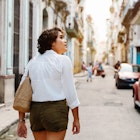
Jan 18, 2024 • 4 min read

Oct 9, 2020 • 3 min read

Street scene with old cars and colorful buildings in Old Havana © Kamira / Shutterstock
Recent changes in travel protocols for Cuba offer a mixed bag of opportunities for North American travelers, opening doors for Canadians, but new US restrictions for Americans.
Theoretically, Cuba has been open for tourists since the beginning of July, although regular visitors – the vast majority of them Canadian – didn’t start trickling back until early September. In the first stage of Cuba’s phased re-opening, international travelers are only permitted to visit several islands off the country’s north coast which are home to all-inclusive resorts but have no permanent Cuban population.
Airlines, spearheaded by Canadian national carrier Air Canada, restarted weekly flights to Cuba’s Jardines del Rey Airport on the island of Cayo Coco in early September operating out of Montreal and Toronto. This idyllic tropical key, along with its neighbors Cayo Guillermo and Cayo Cruz, has been set up to receive international tourists with a raft of special COVID-19 measures. All travelers are given a free COVID-19 test at the airport before being bussed directly to their resort. Hotels are equipped with a resident nurse, doctor and epidemiologist and are staffed by a full team of mask-wearing Cuban employees who are bussed in to work three-week shifts. For visitors, masks are mandatory on airplanes, at airports and on transfer buses but discretionary once you reach the resorts which are mostly open-plan with plenty of alfresco sitting areas. Activities such as snorkeling, boat trips and musical entertainment are all readily available. Guests can also leave the hotel complex unchaperoned but are not permitted outside the protected Cayo Coco travel zone (the island is attached to the Cuban mainland via a 20km-long causeway).

Cayo Coco’s initial opening has, so far, been successful and more resorts are set to restart in mid-October, including Cayo Santa María and Varadero. Aspiring travelers can book all-inclusive packages through , and .
While American citizens are still welcome in Cuba, Department of the Treasury regulations recently updated by the US government make travel there difficult. On September 24, 2020, the Trump administration tightened its Cuba travel restrictions for the third time since 2017. The new rules fall into three main categories. Firstly, it is no longer possible to import Cuban cigars and rum into the US, either directly or through a third country. This re-establishes a directive relaxed by former US president Barack Obama in 2016.

Secondly, US citizens are now barred from staying in any state-run Cuban hotel, a move which effectively bans Americans from every hotel in the country (all Cuban hotels are at least 51% owned by the state). It is still possible to stay in private Cuban homestays, known as casas particulares, but with mainland Cuba closed to international travelers for the time-being, none are currently available to rent. This means that Cuba is technically off-limits to Americans until the country fully reopens.
Lastly, the US government has discontinued two of its 12 authorized categories of travel to Cuba: these are 1) for professional meetings and conferences, and 2) for public performances, clinics, workshops, competitions, and exhibitions. Bear in mind, this still leaves 10 legal categories available for US citizens who wish to travel to Cuba in the future, including the seemingly ambiguous ‘support for the Cuban people’. A full legal document containing all the changes can be read . With a US election looming, these travel restrictions could quickly change.
Hawaii could introduce 'resort bubbles' for quarantined tourists
This airport has been awarded the world's first five-star anti-COVID rating
United plans new flights to Africa, India, Israel and Hawaii


Jan 18, 2024 • 4 min read







